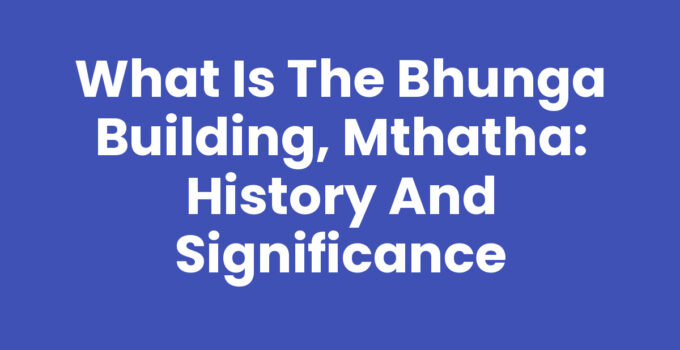The Bhunga Building is a remarkable architectural structure located in Mthatha, Eastern Cape, South Africa. Known for its unique round shape and vibrant cultural significance, this building serves as a vital piece of South African heritage. The history of the Bhunga Building is deeply intertwined with the rich narrative of the Xhosa people and the political movements that shaped this region.
What Is The Bhunga Building, Mthatha: A Detailed Overview
The Bhunga Building was constructed in the early 1950s and designed by the renowned architect, M.P. Nhlapho. Its unique circular design gives it a striking appearance that distinguishes it from other structures in the area. The building was originally intended as a community center for the Xhosa people and has since evolved to become a multi-use facility that houses various cultural and administrative functions.
One of the most significant aspects of the Bhunga Building is its representation of the Xhosa culture. The round structure symbolizes unity and communal living, which are central tenets in Xhosa society. The building’s architecture also reflects the influences of indigenous design principles, merging contemporary and traditional African styles. Over the decades, it has served as a venue for significant cultural events, gatherings, and even political meetings during the fight against apartheid.
Today, the Bhunga Building is recognized as a national monument and continues to play a crucial role in preserving the cultural heritage of the Xhosa people. Visitors to Mthatha often seek out the Bhunga Building not only for its architectural beauty but also for its historical relevance. The building has become a symbol of pride among locals and a point of interest for tourists eager to learn about the history of the region.
Exploring the Architecture of the Bhunga Building
The architectural style of the Bhunga Building is particularly noteworthy. The round design allows for natural ventilation and an open, communal feel within the structure. This architectural choice reflects the lifestyle and sociocultural practices of the Xhosa people, highlighting the importance of community spaces in their daily lives.
Additionally, the use of local building materials showcases the sustainable practices of the time and connects the structure to its environment. The walls are often adorned with colorful murals that depict various elements of Xhosa heritage and storytelling, adding an artistic layer to its appearance and inviting visitors to engage with the local culture.
Furthermore, the interior of the Bhunga Building is just as significant. It typically houses exhibition spaces, community meeting rooms, and areas for performing arts, thus continuing to serve its initial purpose as a center for cultural exchange. The design elements within the building often utilize traditional Xhosa patterns, further embedding the culture into the architectural framework.
The Cultural Significance of the Bhunga Building Today
In modern times, the Bhunga Building remains a vital landmark for the Xhosa community and is used for various events ranging from cultural festivals to educational programs. It is a site of cultural pride, fostering a sense of identity among the local populations.
The building is also pivotal in educational initiatives aimed at teaching younger generations about their heritage, history, and the importance of community. Guided tours often incorporate storytelling sessions to pass down knowledge about the building’s significance, making it a living museum of sorts.
Moreover, the Bhunga Building has become a popular spot for cultural exchanges and collaborations, drawing attention from artists, historians, and tourists alike. It encourages local craftsmanship and artistic expression, embracing both the historical and contemporary Xhosa culture.
As a national monument, there are efforts to maintain and restore the structure, ensuring that it remains a key part of the Mthatha landscape. Restoration projects often involve input from local artists and community members to ensure authenticity and respect for the original design while integrating modern needs.
Conclusion
The Bhunga Building in Mthatha is much more than just an architectural wonder; it is a symbol of cultural resilience and community spirit. Its unique architecture, historical significance, and continued relevance in the lives of the Xhosa people make it a noteworthy destination. Whether you are a history enthusiast, a cultural explorer, or simply curious about South African heritage, the Bhunga Building offers a rich narrative waiting to be discovered.
Frequently Asked Questions
What is the history behind the Bhunga Building?
The Bhunga Building was constructed in the early 1950s as a community center for the Xhosa people, symbolizing their cultural identity.
Why is the Bhunga Building architecturally unique?
Its round shape reflects communal living values of the Xhosa culture and incorporates local building materials and traditional designs.
What events are held at the Bhunga Building today?
The building hosts cultural festivals, educational programs, and artistic performances, serving as a hub for community engagement and cultural pride.









